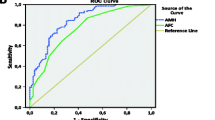Abstract
Objective: Our objective was to determine the effect of elevated early follicular-phase serum follicle stimulating hormone (FSH) levels on follicle growth and oocyte maturity in unstimulated in vitro fertilization (IVF) cycles.
Study Design: We compared cycles with elevated day 3 FSH levels (>20 mIU/ml) to subsequent cycles in the same patients when day 3 FSH returned to normal and to cycles among women with normal day 3 FSH levels.
Patients: Seven cycles in seven patients had an elevated day 3 FSH (high-FSH group). These were compared to 11 subsequent cycles in which there was a return to a normal baseline FSH and to 13 cycles in 13 patients that entered the unstimulated protocol with a normal baseline day 3 FSH.
Results: The day of human chorionic gonadotropin (hCG) administration was similar in all groups as were the serum estradiol (E2) levels. Although the high-FSH group tended to have smaller maximum follicular diameters, the difference was not statistically significant. The highest FSH level on cycle day 3 in a completed cycle was 56.2 mIU/ml. The total number of oocytes aspirated and the number of embryos obtained was similar in all groups. Whereas there were no pregnancies in the high-FSH group, 2 of the subsequent 11 normal day 3 FSH cycles resulted in clinical pregnancies. Two of the 13 patients in the normal day 3 FSH values also achieved pregnancies.
Conclusions: We conclude that cycle day 3 serum FSH levels as high as 56.2 mIU/ml may be associated with apparently normal follicular growth, oocyte fertilization, and embryo cleavage in unstimulated cycles. However, pregnancies are not observed. In addition, FSH levels vary widely from cycle to cycle and elevated levels in one cycle do not necessarily imply that pregnancy may not occur in a subsequent cycle when FSH levels return to normal.
Similar content being viewed by others
References
Scott RT, Toner JP, Mausher SJ, Oehninger S, Robinson S, Rosenwaks Z: Follicle-Stimulating hormone levels on cycle day 3 are predictive of in vitro fertilization outcome. Fertil Steril 1989;51:651–654
Muasher SJ, Oehninger S, Simonetti S, Matta J, Ellis LM, Liu H-C, Jones GS, Rosenwaks Z: The value of basal and/or stimulated serum gonadotropin levels in prediction of stimulation response and in vitro fertilization outcome. Fertil Steril 1988;50:298–307
Paulson RJ, Sauer MV, Francis MM, Macaso TM, Lobo RA: In vitro fertilization in unstimulated cycles: A clinical trial using hCG for timing of follicle aspiration. Fertil Steril 1990;76:788–791
Foulot H, Ranoux C, Dubuisson JB, Rambaud D, Aubriot FX, Poirot C: In vitro fertilization without ovarian stimulation: A simplified protocol applied in 80 cycles. Fertil Steril 1989;52:617–21
Rosen GF, Lobo RA: Further evidence against dopamine deficiency as the cause of inappropriate gonadotropin secretion in patients with polycystic ovary syndrome. J Clin Endocrinol Metab 1987;65:891
Jones GS: Use of purified gonadotropins for ovarian stimulation in IVF.In New Clinical Issues in In-Vitro Fertilization, Wood EC, Trounson AO (eds). London, Saunders, 1985;775
Sherman BM, West JH, Korenman SG: Analysis of LH, FSH, estradiol, and progesterone concentrations during menstrual cycles of older women. J Clin Endocrinol Metab 1976;42:629–633
Cameron IT, O'Shea FC, Rolland JM, Hughes EG, De Kretser DM, Healy DL: Occult ovarian failure: A syndrome of infertility, regular menses, and elevated follicle-stimulating hormone concentrations. J Endocrinol Metab 1988;67:1190–1194
Seifer DB, Canick JA, Seltman HJ, Frishman GN, Berk CA: Comparison of serum FSH values between LEECO RIA and abbot IM × two site immunometric assay—method for conversion of values between assays. Presented at the 40th Annual Meeting of the Society of Gynecologic Investigations, Toronto, Canada, March 31–April 13, 1993
Surrey ES, Cedars MI: The effect of gonadotropin suppression on the induction of ovulation in premature ovarian failure patients. Fertil Steril 1989;52:36–40
Author information
Authors and Affiliations
Rights and permissions
About this article
Cite this article
Lindheim, S.R., Sauer, M.V., Francis, M.M. et al. The significance of elevated early follicular-phase follicle stimulating hormone (FSH) levels: Observations in unstimulated in vitro fertilization cycles. J Assist Reprod Genet 13, 49–52 (1996). https://doi.org/10.1007/BF02068869
Received:
Accepted:
Issue Date:
DOI: https://doi.org/10.1007/BF02068869



